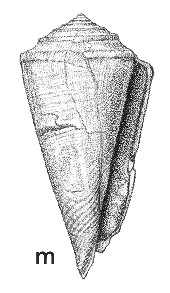
Revised descriptions of New Zealand Cenozoic Mollusca from Beu and Maxwell (1990)

 | Revised descriptions of New Zealand Cenozoic Mollusca from Beu and Maxwell (1990) | 
|
  (Pl. 30m): Maruhou Point, east of Te Araroa, East Cape, Kapitean (M43165, National Museum) |
Beu & Maxwell (1990): Chapter 13; p. 270; pl. 30 m.
Synonymy: Conus (Lithoconus) hendersoni Marwick 1931, p. 131; Conus (sensu lato) hendersoni, Beu & Maxwell 1990, p. 270, pl. 30m.
Classification: Conidae: Coninae
Description: Large for New Zealand Conus species (to about 70 mm high), with very low, stepped, conic spire arid very long, tapered, straight- sided last whorl, long, narrow, parallel-sided aperture with shallow U-shaped sinus on the sutural ramp, and prominent but low, smooth, rounded carina around shoulder of all whorls (i.e., descending spire and forming steps in outline). Apart from growth lines, and few weak, variable, indistinct spiral grooves high on whorls, sculpture is of about 10 low, wide spiral cords on base of last whorl, increasing in prominence down shell. Protoconch not seen.
Comparison: Conus hendersoni is the youngest large Conus species in New Zealand Cenozoic rocks. It may be related to such relatively cool-water living species as C. teramachii (Kuroda, 1956), recorded by Marshall (1981b, p. 499) living at present just to the north of northernmost New Zealand, in 357-677 m; C. teramachii has a similar stepped, carinate spire and basal spiral cords to those of C. hendersoni, but the spire is taller and the carina nodulous in C. teramachii. The presence of a single common species of Conus in Late Miocene rocks near East Cape need only indicate sea temperatures a little warmer than those in the region at present, and only the rather more diverse (but largely undescribed) Conus faunas of Clifden, Southland (Altonian-Clifdenian) and Kaipara Harbour, Northland (Otaian-Altonian) indicate markedly warmer temperatures. Conus is an epifaunal toxoglossan carnivore, feeding on polychaete worms, molluscs or (in a few species) fish, "stinging" its prey with individual, unattached radular teeth and a complex toxin from a well developed poison gland, and the very poisonous fish-eating species of the modern tropics are well known to have killed a few humans. Most species occur on hard substrates in shallow water (on rocky shores and coral reefs), but C. hendersoni has been collected only from soft-substrate environments in mid-outer shelf depths.
The phylogeny of Conus has been investigated by several recent authors, all indicating an essentially simple taxonomy with only two genera. Most recently, Bandyopadhyay et al. (2008) found that the short-spired species of typical Conus (which would include C. hendersoni) all fall into one clade (genus), Conus, whereas the taller-spired and, in many cases, spirally sculptured species similar to the Recent species C. orbignyi Audouin, 1831 and C. viminius Reeve, 1849 all fall into another clade (genus), for which they used the genus Conasprella Thiele, 1929. The relevance of this classification to the usage of the genus Conilithes Swainson, 1840 for New Zealand tall-spired fossils deserves investigation, as it is possible that Conilithes is simply an earlier name for Conasprella. Meanwhile, the traditional name Conilithes is retained for tall-spired fossils.
Distribution: Tongaporutuan-Kapitean; Mangaotuwhito Stream, one km west of main highway, northwest of Tikitiki, near East Cape, Kapitean (type); common and well preserved in the shore platform at Maruhou Point, east of Te Araroa, East Cape (figured), and poor specimens have been collected from many localities in the Gisborne-East Cape district, mostly near East Cape. Most records are from the shallow-water Tokomaru Sandstone facies, as far south as Mangatuna Quarry, inland from Tolaga Bay, and almost all records are Kapitean, but a few are of Tongaporutuan age. One specimen probably assignable here is known from Upton Brook, Awatere Valley (Kapitean).
Cite this publication as: "A.G. Beu and J.I. Raine (2009). Revised
descriptions of New Zealand Cenozoic Mollusca from Beu and Maxwell (1990). GNS
Science miscellaneous series no. 27."
© GNS Science, 2009
ISBN
978-0-478-19705-1
ISSN 1177-2441
(Included with a PDF facsimile file
copy of New Zealand Geological Survey Paleontological Bulletin 58 in CD version
from: Publications Officer, GNS Science, P.O. Box 30368 Lower Hutt, New
Zealand)